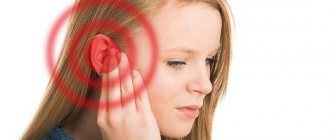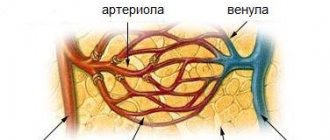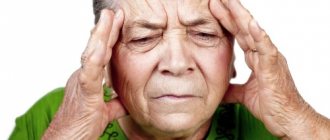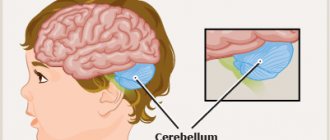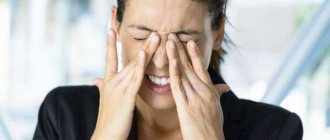Main symptoms:
- Sudden falling asleep
- Hallucinations
- Headache
- Dizziness
- Daytime sleepiness
- Slowness of reactions
- Lethargy
- Muscle weakness
- Heart rhythm disturbance
- Low blood pressure
- Weakness
- Decreased vision
- Decreased performance
- Convulsions
- Increased sleep duration
- Fatigue
Hypersomnia is a sleep disorder characterized by increased rest periods and daytime sleepiness. In this case, the duration of sleep is more than ten hours. It rarely occurs as an independent disorder; it is often a complication of certain diseases. After a long sleep, there is no improvement in the general condition; there is constant drowsiness and problems with waking up.
Online consultation on the disease “Hypersomnia”.
Ask a question to the specialists for free: Neurologist.
- Etiology
- Varieties
- Symptoms
- Diagnostics
- Treatment
- Prevention
Since the mechanism of alternation of sleep and wakefulness is determined in the human body by several processes taking place in the brain, disruption of the functioning of at least one of them leads to the occurrence of this disease. For a healthy adult, sleep duration varies from eight to twelve hours a day, so determining hypersomnia requires taking into account individual characteristics.
Diagnosis is carried out on the basis of instrumental measurement of sleep phases and duration. In addition, during diagnosis it is necessary to distinguish this condition from ordinary increased daytime sleepiness. The only difference is that this disorder is caused by prolonged insomnia. This disorder is several times less common than lack of sleep, and is not always noticeable to the person himself, but is discovered during the diagnosis of completely different diseases. Treatment consists of creating an individual sleep regimen for each patient and treating the underlying disease.
Causes and risk factors
Persistent pathological drowsiness usually develops as a result of organic brain lesions in various diseases and dysfunctions of the central nervous system; Neurological disorders are sometimes accompanied by mental illnesses.
Hypersomnia does not lead to the development of life-threatening or worsening somatic complications.
Hypersomnia can also occur in practically healthy people as a result of acute stressors or chronic psycho-emotional stress. Often, patients can trace a cause-and-effect relationship with some traumatic exposure that preceded the development of hypersomnia. In some cases, the cause of pathological drowsiness is an increased need for sleep that occurs during prolonged and excessive stress.
The most common causes of hypersomnia:
- genetically determined or acquired imbalance of regulatory neurotransmitters;
- viral and bacterial diseases of brain tissue and meninges (encephalitis, meningitis);
- pathology of the hypothalamus and related structures;
- intense acute or chronic stress (military action, threat to life, sudden change in life situation, etc.);
- defect in the central mechanisms of regulation of the sleep-wake regime;
- volumetric neoplasms of the brain;
- side effect of certain medications;
- schizophrenia-like disorders, neurasthenia, depressive spectrum disorders;
- acute cerebrovascular accidents;
- traumatic brain injuries;
- chronic diseases (diabetes mellitus, hypothyroidism, etc.).
Kinds
Hypersomnia is classified by type of origin. There are psychophysiological, idiopathic, pathological, post-traumatic, psychopathic, narcolepsy forms of the disease.
Idiopathic hypersomnia has no obvious cause. It is established by elimination. Post-traumatic occurs due to damage to brain structures. Psychopathic is based on a mental disorder, and narcolepsy is caused by a disorder in which a person experiences an irresistible desire to sleep.
Psychophysiological drowsiness is caused by nervous and physical overload, stress, and pathological drowsiness is caused by infectious, tumor or organic pathologies of the brain.
In addition, there are permanent and paroxysmal forms. Paroxysmal is characterized by sudden attacks of the desire to sleep (this phenomenon occurs with narcolepsy), and permanent is expressed in constant drowsiness during the day.
Forms of the disease
Hypersomnia occurs:
- permanent (permanent);
- paroxysmal (episodic).
Types of paroxysmal hypersomnia:
- narcolepsy;
- Pickwickian syndrome;
- hysterical hypersomnia;
- Kleine–Lewin syndrome;
- lethargic hypersomnia;
- syndrome of hypersomnia and sleepy intoxication.
In healthy people, the duration of night sleep is individual and is not a constant characteristic; on average it is 5–12 hours a day.
Symptoms
The appearance of a permanent form of hypersomnia:
- drowsiness or episodes of sleep during the day (with normal duration of night sleep) and (or) difficulty transitioning to a state of full wakefulness after awakening;
- stable daily nature of the pathological condition for at least 1 month, deterioration of social interactions and work activity;
- no additional symptoms of narcolepsy or sleep apnea.
Symptoms of paroxysmal hypersomnia depend on its form.
Narcolepsy is characterized by:
- daytime sleepiness;
- cataplectic attacks - sudden short-term (within a few seconds) loss of muscle tone;
- disturbance of night sleep - restless, superficial, often with frightening dreams, frequent awakenings with prolonged episodes of insomnia;
- hypnagogic hallucinations – vivid visual and auditory images that occur between wakefulness and sleep, when falling asleep;
- cataplexy of falling asleep (waking up) - immobility lasting from several seconds to several minutes at the moment of falling asleep or waking up, respectively.
Narcolepsy can be polysymptomatic (with cataplexy) or monosymptomatic (without episodes of cataplexy). In the polysymptomatic form, drowsiness is paroxysmal, often developing in the first half of the day, patients report vivid dreams reflecting the events they have experienced.
With hypersomnia, sleep onset cataplexy may occur.
The monosymptomatic form is characterized by the appearance of drowsiness in the evening or afternoon. At the beginning of the disease, patients try to fight drowsiness to no avail, aggravating the condition. Hypersomnia in this case is often combined with preservation of motor acts: a patient who has suddenly fallen asleep continues to stand, walk, talk, and perform current activities; if the attack develops less rapidly, the patients manage to take a comfortable position. An episode of drowsiness lasts several minutes, the frequency of attacks is from one to dozens per day, usually three or four. After the episode of drowsiness, patients feel alert and return to previous activities.
Pickwickian syndrome is a combination of obesity, breathing problems (rapid, shallow breathing movements) and daytime sleepiness. With this pathology, night sleep is also disturbed; it does not bring cheerfulness; patients complain of fatigue and morning headache.
Hypersomnia can be either permanent or episodic.
The manifestation of Kleine-Lewin syndrome is a combination of periodic attacks of hypersomnia and bulimia. It occurs more often in young men and boys. A sleep episode is preceded by mental and motor agitation and insomnia. A characteristic sign of the syndrome is the consumption of food in inadequate, excessive amounts during an attack or the day before, while patients are not characterized by a purposeful search for food; they eat only what catches their eye. The duration of an attack in Kleine-Lewin syndrome can reach several weeks. With spontaneous awakening, confusion and confusion arise, with forced awakening, aggression may occur.
Hypersomnia that occurs with Kleine-Levin syndrome is combined with bulimia
The main sign of hysterical drowsiness is a previous psychotraumatic situation. Outwardly, the patient is in a state of deep sleep, but it is almost impossible to wake him up. There is no urination, stool retention is observed, while the reaction of the pupils to light remains, the patient’s attempt to passively open the eyes meets resistance. Skin sensitivity is significantly reduced, muscle tone is increased, blood pressure is normal, tachycardia and increased sweating of the palms and feet are noted. The EEG shows a characteristic picture of wakefulness.
Lethargic hypersomnia is manifested by limitation of physical manifestations of life, immobility, significant slowdown of metabolism, weakening or absence of reaction to stimuli, even intense ones. In severe cases, a picture of imaginary death is formed: the skin and visible mucous membranes are pale, cold, the pupils do not react to light, breathing is difficult to determine, and there is no pulse in the peripheral arteries. Patients do not drink or eat, and the excretion of urine and feces stops. Both the development of an episode of lethargy and its resolution are sudden.
Features of the syndrome of hypersomnia and sleep intoxication are lower frequency and longer duration of sleep compared to narcolepsy. In this case, there are no signs of a narcoleptic complex; a triad of symptoms is characteristic - daytime drowsiness, prolongation of night sleep and confusion after waking up, lasting from 15 minutes to 2 hours.
Clinical picture
The normal course of sleep largely depends on the activity of the nervous system. It is she who is responsible for vital processes occurring in the body, including sleep. If for any reason the function of the nervous system is impaired, serious disorders may develop, which also affects the quality of sleep.
Regardless of the fact that idiopathic hypersomnia is characterized by pronounced symptoms, people rarely visit a medical specialist, and do not even want to carry out treatment at home. Since many of them suggest that such manifestations are associated with emotional disorders or physical stress.
Symptoms
Idiopathic hypersomnia has a number of symptoms characteristic of this disease:
- increased drowsiness;
- development of snoring;
- sudden onset of sleep;
- the appearance of an attack of apnea during sleep;
- fatigue, malaise;
- lack of proper sleep;
- headaches, dizziness;
- visual impairment;
- the risk of developing seizures increases;
- change in heart rate;
- short-term cessation of motor activity, leading to muscle paralysis;
- hypertensive crisis.
The listed symptoms can accompany a person throughout his life. Most of them appear at the wrong time. Therefore, many people are forced to lead a “home” lifestyle: leave work and limit their social circle.
Diagnostics
Diagnosis of hypersomnia is based on characteristic symptoms, the results of genetic counseling and a comprehensive analysis of the results of such studies:
- assessment of the patient’s condition using the Stanford Sleepiness Scale and Epworth Sleepiness Scale, which objectively reflect the degree and characteristics of sleep disorders;
- multiple sleep latency test (MLST), which assesses the biological need for sleep;
- polysomnographic study, including electroencephalographic, electrooculographic and electromyographic studies with subsequent assessment of the results in their entirety;
- assessment of somatic support (concomitant diseases that reduce the quality of life and affect the sleep process).
A consultation with a psychologist (psychotherapist) is also provided.
Polysomnography helps determine the cause of hypersomnia
Preventive Actions
There are objective circumstances that are impossible to fight, then it’s worth restructuring your life to suit them. Ways to prevent the problem:
- adhere to a daily routine with a clear alternation of periods of sleep and wakefulness;
- if possible, avoid getting into stressful situations;
- ensure the availability of fresh air throughout the day;
- monitor the state of the central nervous system.
An active lifestyle, frequent exposure to nature and a philosophical outlook on life can improve the quality of life and minimize the reasons why a person sleeps all the time. It would be useful to use folk remedies to normalize the functioning of the nervous system. Many herbal recipes can be found on the Internet.
The manifestation of a disease such as idiopathic hypersomnia in its pure form is a rare case. You should not make a complex diagnosis on your own, since abnormal daytime sleepiness as a concomitant symptom may indicate many problems of the immune and nervous system. But it is important to be understanding towards people who have been diagnosed with a similar disease. In most cases, they are forced to struggle with the problem throughout their lives.
Treatment
Drug therapy:
- stimulants;
- nootropics;
- antidepressants.
Frequent bouts of drowsiness negatively affect a person's normal functioning and social activities.
Non-pharmacological interventions:
- psychotherapeutic effects (relaxation techniques, techniques for limiting stimulation and limiting sleep);
- physiotherapeutic procedures;
- normalization of sleep hygiene.
Psychotherapy and relaxation techniques are useful for hypersomnia





